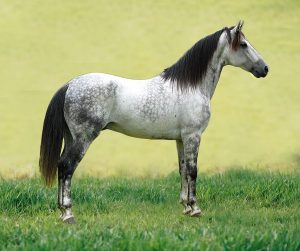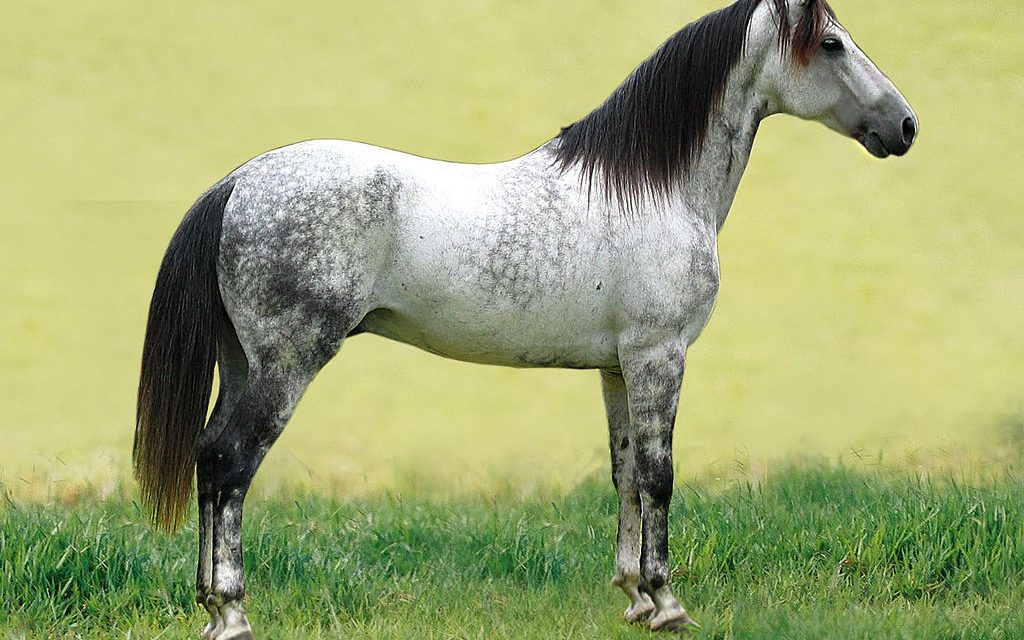By Lynn Kelley
 When we retired in Arizona, me and my husband became fascinated with horses and riding through the Sonoran Desert. I had owned beautiful Arabian horses back on the East Coast, but needed to find a more calm and reliable horse for us both to ride together. I searched the internet using words like “versatile”, “easy to ride”, “strong bones”, “good feet” and most of all “beautiful”.
When we retired in Arizona, me and my husband became fascinated with horses and riding through the Sonoran Desert. I had owned beautiful Arabian horses back on the East Coast, but needed to find a more calm and reliable horse for us both to ride together. I searched the internet using words like “versatile”, “easy to ride”, “strong bones”, “good feet” and most of all “beautiful”.
The internet’s result was the Mangalarga Marchador (MM), the National Horse of Brazil. Careful breeding and the Brazilian inspection process is the key to retaining the qualities that people love about these horses. In Brazil they inspect the horses before they’re allowed to breed, so there is consistent quality in the Marchador breed. It is a breed that descends directly from ancient Iberian stock. This gaited horse is known and bred for its smooth step – the marcha. It has a gentle temperament, intelligence, stamina and a comfortable ride.
In Brazil, our friends weave the history of the Marchador as if telling an epic legend. Eyes glowing and with great pride, the breeders recount the sires and the mares that were the foundation of the breed. Breeding horses for generations, you might say the Mangalarga Marchador is in their blood.
The Mangalarga Marchador stands between 14.2 and 16 hands, averaging 15 hands and weigh between 850 and 1100 pounds. Gray is prominent, but chestnuts, blacks, bays, buckskins, palominos and pinto horses may also be found. A versatile, sure-footed horse with plenty of cow sense as well as stamina, this breed holds the Guinness book of World Records Endurance Ride of 8,694 miles in 1994.
The two special gaits are “marcha picada” and ‘marcha batida”. Both are four beat gaits and provide moments of triple hoof support. The picada is a lateral gait and the batida is diagonal. Personal preference and riding terrain determine which one is better. The Marchadors all possess a wonderful canter, which does not disturb their natural marcha. The marcha picada is a bit smoother. It is a broken pace and therefore creates little vertical movement. The gait can be sustained for long periods of time, allowing the rider hours of enjoyable riding with little discomfort.
 The timing of footfalls is similar to the paso llano of the Peruvian Paso Horse. In Portuguese, Batida means to hit and describes the gait considered to be a broken trot. This gait, unlike a trot, shows very little suspension as the horses is always in contact with the ground. This creates stability and smoothness. The longer and more frequent the moments of triple hooves support are, the more comfortable the gait will be.On flat ground, performing the batida at a normal speed, the hind foot overreaches the track of the forefoot on the same side, adding to the smoothness of the ride.
The timing of footfalls is similar to the paso llano of the Peruvian Paso Horse. In Portuguese, Batida means to hit and describes the gait considered to be a broken trot. This gait, unlike a trot, shows very little suspension as the horses is always in contact with the ground. This creates stability and smoothness. The longer and more frequent the moments of triple hooves support are, the more comfortable the gait will be.On flat ground, performing the batida at a normal speed, the hind foot overreaches the track of the forefoot on the same side, adding to the smoothness of the ride.














